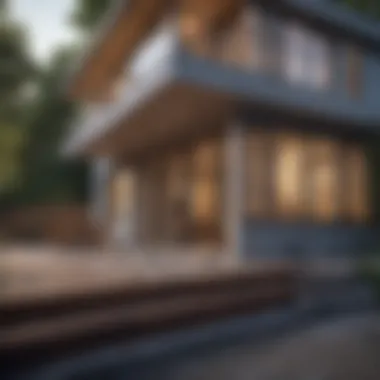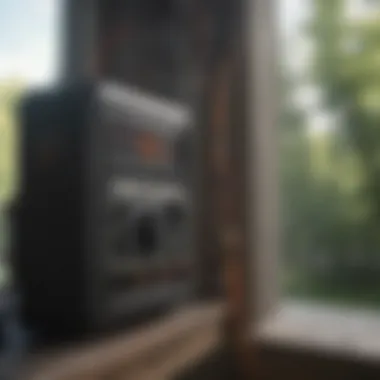Essential Checklist for Residential Property Inspections


Intro
When it comes to buying a home or making sure that your current one is in tip-top shape, having a thorough checklist is not just a luxury—it's a necessity. A residential property inspection checklist acts like a roadmap, guiding potential buyers or homeowners through the myriad aspects of a property, ensuring that no stone is left unturned. From assessing the often-overlooked plumbing systems to evaluating safety features that may seem minor at first glance, each area carries its own weight in the overall health of a residence.
Why is this important? Because the implications of skipping these inspections can be substantial. Consider this: neglecting to assess the state of a roof can lead to water damage and expensive repairs down the line. The same goes for outdated electrical systems—what might appear as a simple wiring issue could spell disaster if not caught early. By using a comprehensive checklist, you’re not merely inspecting; you’re making an informed decision that could save you both time and money in the long haul.
Moreover, let’s talk aesthetics and neighborhood quality—factors that often slip through the cracks during inspections. How does the home fit within its surroundings? What about the potential for future value? Such elements can have a direct impact on living experience and investment opportunities. By delving into a well-crafted checklist, you're arming yourself with the knowledge needed to navigate these concerns wisely.
In the following sections of this article, we will explore various vital components of a thorough home inspection, delving into the importance of each aspect and offering insight on how they intertwine to create that perfect living environment. Now, let's roll up our sleeves and start examining the heart of residential inspections.
Understanding the Importance of a Property Inspection
When navigating the complexities of real estate, understanding the importance of a property inspection is like having the right map before setting out on a journey. Many homebuyers and sellers overlook this crucial step, thinking it might add unnecessary time or cost to their real estate transaction. However, skipping it could lead to regrettable decisions down the line.
A property inspection serves as a comprehensive examination of a home’s condition, unearthing potential pitfalls that might not be visible at first glance. Without it, buyers may find themselves betwixt a rock and a hard place, faced with unexpected repairs that could chip away at their finances.
Definition of a Property Inspection
A property inspection is a thorough assessment conducted by a qualified inspector. It examines the various components of a home, ranging from structural integrity to the functionality of its mechanical systems. An inspection typically covers:
- Foundation - checking for cracks or settling issues.
- Roof - assessing for wear, leaks, or deterioration.
- Mechanical systems - evaluating plumbing, electrical, heating, and cooling.
- Interior and exterior - looking at finishes, surfaces, and overall safety.
Each aspect of the inspection aims to provide a snapshot of the property’s current state, ensuring that no stone is left unturned. It’s not just a checklist; it’s a key element in the property transaction process.
Benefits for Buyers and Sellers
The benefits of conducting a property inspection are manifold for both buyers and sellers. Here’s how a detailed inspection can make waves:
- Informed Decisions - Buyers gain insight into potential issues before closure, helping them make more informed choices.
- Negotiate Repairs - Discovering problems allows buyers to negotiate repairs or price adjustments, making it easier to manage expectations.
- Peace of Mind - Knowing the home's condition provides buyers peace of mind, adding to the emotional comfort of purchasing.
- Disclosure Compliance - For sellers, providing an inspection report promotes transparency, reducing the likelihood of post-sale disputes.
- Market Value Insight - Sellers can use inspection findings to price their property accurately, aligning expectations with market conditions.
"A property inspection is not just about finding faults; it's about understanding the entire picture to make informed decisions."
Structural Aspects of the Property
When it comes to evaluating a residential property, the structural aspects play a pivotal role. Understanding how a home is built not only tells you about its current state but also hints at potential future issues. Buyers and sellers alike should prioritize these elements to ensure that they are making sound investments. If the foundation falters, the rest of the house crumbles; that’s just the way it is. So, being thorough in this area is like planting your feet firmly on solid ground.
Foundation Integrity Assessment
A home’s foundation is its backbone. If there are cracks, shifting, or signs of water damage, those should wave red flags louder than a bullfighter’s cape. Checking for uniform settling is critical, as irregularities can indicate serious issues. During this assessment, look for things like:
- Cracks in walls or ceilings. These can hint at a shifting foundation.
- Water pooling in the basement or yard. This signals drainage issues.
- Slopes in flooring. A sloped floor can show that the foundation is sinking.
By addressing these red flags early, homeowners can save themselves sleepless nights and hefty repair bills down the line. It’s a bit like catching a cold before it turns into pneumonia.
Framing and Walls Examination


After the foundation, the next logical step is to inspect the framing and walls. This part of the house tells a story about its stability and longevity. Make sure to check for:
- Signs of moisture damage—such as discoloration or mold. Moisture can cause wood to rot.
- Termite damage—little critters can be a homeowner’s worst nightmare.
- Uneven walls—which may suggest settlement issues or framing problems.
The frame is what holds everything together; if it's compromised, the home's integrity is at risk. Ensuring these elements are in good shape can mean the difference between a cozy home and a money pit.
Roof Inspection Techniques
The roof is perhaps one of the most crucial components, acting as the first line of defense against the elements. A solid roof can withstand storms, snow, and hail, but it must be regularly inspected to prevent leaks and significant damage. Key points to evaluate include:
- Shingle condition: Look for curling, missing shingles, or granules in the gutters.
- Flashing issues: This could lead to leaks around chimneys or skylights.
- Drainage systems: Ensure gutters aren’t clogged and directing water properly away from the house.
Slapping a band-aid on roofing problems can lead to far worse headaches later. Just like a penny saved can be a penny earned, catching roofing issues early can save you a small fortune in repairs.
"Always inspect the roof from the ground level first; occasionally, all you need is a good set of binoculars to spot trouble."
Interior Features to Inspect
When assessing a residential property, the interior features often tell the most nuanced stories about the home's condition and livability. It’s essential to delve into aspects like flooring, wall surfaces, windows, and doors to catch any lurking issues that could affect comfort— or your pocketbook. A thorough examination in this category not only enhances appreciation of the home's aesthetic qualities but also aids in recognizing necessary repairs or upgrades before you invest. Understanding these elements can effectively guide potential buyers, residents, or investors in making informed choices and preserving the property’s long-term value.
Flooring and Surface Condition
Floors are the foundation upon which a home stands— both literally and figuratively. An inspection of flooring and surface condition is paramount for several reasons. Different materials, from hardwood to carpet or tile, age in unique ways that may impact durability and comfort.
- Signs of Wear and Tear: Look for uneven surfaces or carpet fraying. Small imperfections can indicate bigger underlying issues, such as water damage or poor installation.
- Material Suitability: Ensure that the flooring material matches the intended use of the room. For instance, it’s common to find slippery tiles in areas like the kitchen or bathroom, posing a safety risk.
- Maintenance History: Inquire about past care. For example, wooden floors may require periodic refinishing, while carpets might be best served with regular deep cleaning.
Inspection goes beyond just visual checks. It’s prudent to knock on surfaces or feel them underfoot— with adequate discernment, one can spot subtle inconsistencies that could lead to complications down the road.
Walls, Ceilings, and Paint Quality
Walls and ceilings function as the canvas of a home, showcasing the interior's aesthetic and structural integrity. They protect against elements while also maintaining warmth and comfort within the living space.
- Monitoring for Cracks and Damage: Small cracks on walls can signal shifts in the foundation or humidity-related issues. Assess the size and pattern of these cracks. Horizontal cracks may indicate more severe foundational problems.
- Paint Peeling or Discoloration: This often heralds moisture problems. Affected areas might require not just a fresh coat of paint, but also repair of hidden water damage. Inspect for the presence of mold, especially on ceilings prone to steam from bathrooms.
- Overall Aesthetic Appeal: The choice of colors, textures, and materials contributes significantly to the overall ambiance. A well-painted home not only feels inviting but also indicates proper upkeep.
The quality of walls and ceilings can lend insight into previous renovations or repairs, which may give an idea about the overall maintenance culture of the household.
Windows and Doors Functionality
Windows and doors serve as the gateways to any home— both from a practical standpoint and in terms of aesthetic. Proper functioning is vital for energy efficiency, security, and comfort.
- Checking Operation: Open and close all windows and doors. Sticking or difficulty in operation can indicate misalignment or foundation issues. Pay attention to gaps that might allow drafts.
- Glass Condition: Inspect for cracks, fogging, or moisture between double-pane glass. Such defects lessen energy efficiency and can indicate potential replacements down the line.
- Lock and Security Check: Ensure locks are functional. A secure home begins with robust doors and windows, providing peace of mind against intrusions.
"Investing in the quality of windows and doors is not just about looks; it’s about safeguarding your investment and ensuring comfort and safety within your abode."
Mechanical Systems Review
The mechanical systems of a residential property are the unsung heroes behind the comfort and safety of everyday life. An in-depth review of these systems during a property inspection can reveal insights that are crucial for buyers, sellers, and homeowners alike. When you think about it, every time you turn on the heater, flush a toilet, or flick a light switch, you're relying on a network of mechanical components that must function reliably. Failing to scrutinize these elements may lead to unexpected repairs or safety hazards down the road.


Heating and Cooling Units Evaluation
An effective heating and cooling unit is more than just a convenience; it's vital to maintaining a healthy living environment. Evaluating these systems requires more than a cursory glance. Consider checking the age of the unit, as older systems tend to become less efficient and can affect your utility bills. Professionals must look for signs of wear and tear, such as rust on the exterior of furnaces or the presence of leaks in air conditioning systems.
Maintenance records can give valuable insight into how well the systems have been cared for. Also, running the system while an inspector is present will provide the opportunity to observe any odd noises or inefficiencies. In places where summers are scorchers and winters can put you through the wringer, a functional heating and cooling unit is non-negotiable.
Plumbing System Integrity
The plumbing system is another critical component that demands close inspection. It’s not just about making sure the water flows when you turn the tap; you must look for leaks, water damage, and the condition of pipes. Start with the visible areas — check under sinks and around toilets for any water stains, which often indicate an ongoing problem.
Many older homes may still have galvanized pipes that are prone to corrosion, which can affect water quality and pressure. Additionally, it’s important to check the water heater for age and efficiency. If it’s nearing the end of its expected lifespan (usually around 10-15 years), it’s wise to consider budgeting for a replacement.
"A small leak might be a simple fix today, but if ignored, it could lead to major water damage tomorrow."
Electrical Systems and Safety Checks
Electricity runs the modern world, so ensuring your property’s electrical systems are up to par is imperative. A thorough evaluation should start with checking the electrical panel for outdated components or any signs of overheating. Any dangling wires or frayed cords are obvious red flags; they can not only drive you up the wall but also present significant safety risks.
It’s also essential to test outlets and switches. Are they functioning properly? Do the lights flicker when you switch them on? Buyers should also be aware of the home's grounding system; a grounded electrical system is paramount for preventing electrical shocks. Furthermore, the addition of GFCI outlets in areas susceptible to moisture, like kitchens and bathrooms, is a simple tweak that makes a world of difference in safety.
In summary, a detailed mechanical systems review sheds light on key elements that are often overlooked but can make or break a home’s comfort and safety. Being thorough in this review can not only save money but also enhance peace of mind for anyone making one of the largest investments of their lives.
External Factors and Surroundings
When considering a residential property, it's vital to realize that the physical structure is just one piece of a larger puzzle. The external factors and surroundings can have a substantial impact on the livability and long-term value of a home. These elements range from the immediate landscaping and site drainage to the condition of nearby properties and accessibility to amenities and services. Neglecting this aspect could lead to futures full of surprises and regrets. Understanding these considerations becomes a game changer for anyone poised to make a real estate investment.
Landscaping and Drainage Assessment
A property’s appeal often begins with its landscaping. A well-maintained yard or garden not only enhances curb appeal but also suggests that the previous owners cared for the property. However, it’s not just about aesthetics; functional landscaping plays a role in preventing water damage and maintaining the property’s integrity.
- Evaluate the grading: Is the land sloped away from the home? Proper grading directs water away from the foundation, preventing possible flooding or erosion.
- Inspect drainage systems: Assess the gutters, downspouts, and any visible drainage solutions. Clogged or broken systems can lead to serious issues.
- Examine plant choices: Certain plants are better for areas prone to water accumulation. Indigenous species can often handle local weather conditions effectively while enhancing natural beauty.
Conducting a landscaping and drainage assessment isn’t merely about looking pretty. It provides homeowners peace of mind regarding maintenance costs and issues that could arise later on.
Fencing and External Structures Analysis
Fencing and any external structures can either uplift a property’s appeal or significantly detract from it. Understanding these elements is crucial for prospective buyers or those looking to maintain their investment.
- Condition of the fences: Is the fence leaning or broken? A lot can be said about the upkeep of these external barriers. Neglected fences or structures may seve as a red flag for other undisclosed maintenance issues.
- Check for safety hazards: Aside from aesthetics, safety must be paramount. Any sharp edges, rusted gates, or unstable structures pose a risk and might necessitate immediate action.
- Evaluate surrounding structures: Look into neighboring buildings or structures. A property right next to a dilapidated building can hurt market value and personal safety perception.
By performing a thorough fencing and external structures analysis, homeowners can pinpoint potential repairs or improvements that protect their investment and enhance overall living conditions.
Neighborhood Quality and Accessibility
The neighborhood plays a pivotal role in the overall experience of homeownership. Assessing this external factor will shed light on both immediate and long-term implications for one's investment.


- Examine neighborhood amenities: Are there schools, parks, grocery stores, or entertainment venues nearby? These amenities can make a location much more desirable.
- Analyze accessibility: Consider the transport options. Access to public transport or major highways can make commuting more convenient and increase property values.
- Research community dynamics: A vibrant neighborhood can be a major selling point. Friendly neighbors, well-organized community activities, and low crime rates often create a sense of belonging that can’t be overlooked.
"The neighborhood isn’t just part of the property; it often defines the lifestyle that comes with it."
A focused look at neighborhood quality and accessibility not only allows a prospective buyer to evaluate the current living conditions but also helps predict future market trends, ultimately informing their decision-making process.
By taking the time to delve into these external factors and surroundings, buyers and homeowners alike can make choices that align with their long-term aspirations and realities.
Documentation and Reporting
In the realm of real estate, documentation and reporting play a pivotal role in ensuring that both buyers and sellers engage in a transparent transaction process. This segment explores the critical aspects surrounding documentation, which not only serves as a record of the inspection but is also fundamental in protecting the interests of all parties involved. A meticulous documentation process strengthens confidence in transactions and helps avert potential disputes down the line.
A well-crafted inspection report highlights significant findings, providing invaluable insights into the property's condition. This documentation is like a roadmap, guiding stakeholders through what might lie behind walls or below floors, thus illuminating necessary repairs or concerns. Buyers can leverage these reports to negotiate better terms and prices, while sellers can pinpoint issues needing resolution before listing their property.
Creating a Detailed Inspection Report
The essence of a detailed inspection report lies in how it encapsulates findings during the inspection phase. An effective report serves several purposes:
- Transparency: It reflects the integrity of the inspection process, allowing buyers to have a clear picture of what they're investing in.
- Clarity: Should your report be inundated with jargon or technical phrases, it can fall flat. Hence, clarity in language is essential. Use straightforward terms that anyone can understand, perhaps even including a glossary for complicated terms.
- Comprehensive Overview: A good report touches all the bases – from structural weaknesses to external influencing factors. The typical layout includes sections for various components, such as:
- Structural aspects
- Interior features
- Mechanical systems
- External factors
Moreover, visuals—photos and diagrams—can substantiate written claims, bringing them to life. For instance, showing evidence of mold growth or damaged roofing can significantly bolster your argument for negotiating a lower price. A thoughtfully compiled report can also provide evidence for maintaining your property long-term, allowing homeowners to build a comprehensive maintenance schedule.
Understanding Disclosure Requirements
The term disclosure requirements is often a maze for homeowners and buyers alike. Knowing what must be disclosed – and what is merely a recommendation – is essential for making informed decisions. Sellers are obligated to disclose certain issues, such as structural problems or pest activity, that could affect the property’s value or desirability. The specifics of these requirements vary from state to state, but the underlying principle remains: honesty is the best policy.
- Legal Obligations: Familiarize yourself with communal requirements to avoid legal repercussions. Not disclosing pertinent issues could result in lawsuits, which is a costly headache.
- Building Trust: When sellers offer transparency regarding property condition, trust blossoms. It not only puts them in a better light but also enhances the buyer’s confidence in making an offer.
- Protecting Buyers’ Interests: Understanding these requirements encourages buyers to ask informed questions and demand inspections as needed. It urges them to validate the presentation of the property against the backdrop of factual information.
"In real estate, accurate disclosures are not just good practice; they're critical to maintaining your reputation and staying clear of legal burnouts."
Ongoing Maintenance Considerations
Understanding ongoing maintenance considerations is crucial, especially when it comes to preserving the value of a property over time. A property inspection checklist doesn’t just end with the inspection report; it's a guide for an ongoing journey of upkeep. Regular maintenance is an investment that ensures a home remains safe, comfortable, and appealing over the years. It also plays a pivotal role in protecting your financial investment from unforeseen expenses and potential drop in value due to neglect.
Routine Inspections and Upkeep
Routine inspections are the backbone of proactive maintenance. This isn’t just about having a checklist and ticking off items. It involves developing a keen eye for the minute details that can indicate larger issues down the line. Consider scheduling seasonal inspections—align with the weather changes to address specific concerns according to each season's wear and tear.
- Roof inspections: Check for signs of damage after heavy snow or storms. A shingle might look fine on the surface, but a closer look could reveal cracking or curling.
- Gutter cleaning: This shouldn’t be overlooked. Clogged gutters can lead to water damage and exacerbate foundation issues.
- Heating and cooling systems: Regularly change filters and schedule professional servicing to ensure efficiency.
In this phase, don’t hesitate to document any findings and keep records. This can serve both as a maintenance history and a valuable asset during future sales discussions.
Long-Term Property Value Preservation
Keeping an eye on long-term property value preservation often means thinking ahead. This could mean not just maintaining what’s present, but also making wise upgrades that enhance value without breaking the bank. It’s often tempting to go for the latest trends in home improvement, but understanding what truly adds value is critical.
- Energy efficiency upgrades: Improvements like better insulation or energy-efficient windows can significantly reduce utility bills and make the property more attractive to buyers in the future.
- Curb appeal: The exterior is the first impression. Investing in landscaping or repainting can catch the eye of potential buyers and maintain the property’s charm.
- Regular assessment of local market trends: Changes in the neighborhood can affect your property’s value. Keep tabs on local developments or newer amenities being added, as they might influence your future decisions.
Proactive maintenance not only helps prevent bigger issues but also can enhance your property’s value, ensuring that you get the best return on your investment when the time comes to sell.
By embracing ongoing maintenance considerations, you become not just a homeowner but a steward of your property's future. It fosters a sense of responsibility that extends beyond mere ownership, involoving both emotional and financial commitment.



